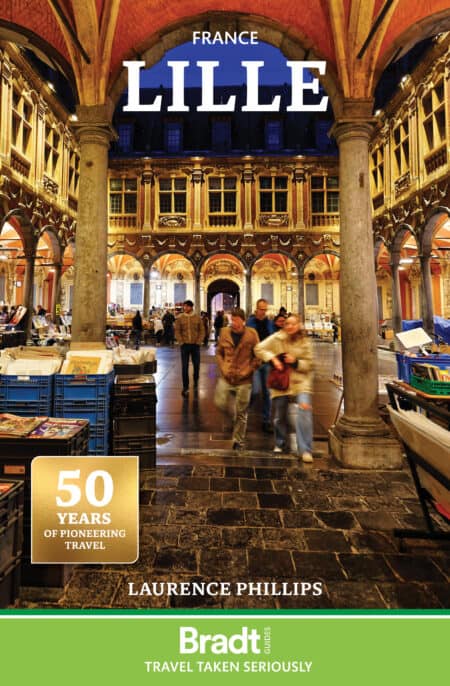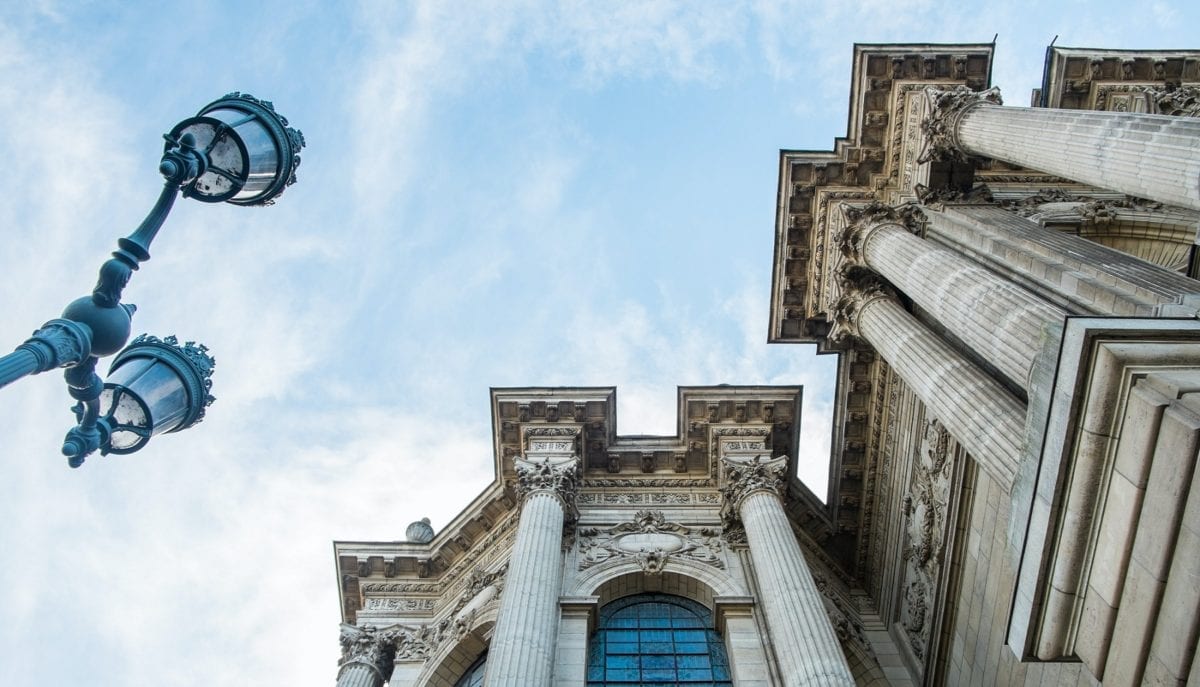Let music follow your footsteps into history, let your taste buds tempt you from your chosen path. Let lunch segue into dinner, Art Deco streets lead you to the talents of tomorrow and the sounds of a lone midnight saxophone from an open window in the lamplight blend into a bedtime serenade in a city that, more than any other, knows the value of a great lullaby.
Laurence Phillips author of Lille: The Bradt Guide
France is one of our hot destinations for the year ahead – check out the full list of the best places to travel in 2024 here.
Any trip to Lille is both a visit to a dear old friend and a heady whirlwind romance with a stranger. Twenty years after being whisked off my feet by my first encounter with the city that composed the anthem that launched a hundred revolutions, but erected a statue to a lullaby, I was seduced afresh when I stumbled across dozens of people dancing a tango in a Renaissance cloister in the September rain.
Lille is whatever you want it to be. Whatever you are looking for you’ll find it here, ten minutes after stepping off the Eurostar. The bargain hunter heads down to the Sunday flea market in Wazemmes, the fashionista hits the designer boutiques of the 16th-century cobbled streets of Vieux Lille. Some of us dress up for a first night in the gilded crystal jewel box of the opera house, others seek out Monets and Goyas at the Palais des Beaux-Arts. You’ll find the cream of European art looted by Napoleon in one gallery, and creations by the enfants terribles of today’s art world in a old post office by the railway tracks.
And all of this is just to work up an appetite for the food. Lille is where France’s top chefs go to play: find the bistro with a Michelin star, grab world food in a street corner bar or check out the young talent tipped by the critics as the next generation to watch.
Bon voyage, bon weekend and bon appetit!
For more information, check out our guide to Lille:
Food and drink in Lille
Food and drink matter in Lille. The best argument of the day is deciding where to eat – a tavern serving savoury tarts with fresh-brewed beers; an old-fashioned traditional brasserie; gastronomic elegance with starched linens and eloquent menus to set the pulse racing; or a moody jazz café by the city walls.
Food
There are so many flavours to be discovered that one mealtime is simply not enough. From one table to the next, you may segue from that which makes Lille French and that which sets it so very much apart. Regional specialities are a happy blend of the Flemish and northern French styles. Dishes may feature the cheeses of Mont des Cats and Maroilles, genièvre juniper gin, the famous Blanche de Lille white beer and other local brews, all tickled with local wisdom to transform the simplest of ingredients into something special.
Waterzooï, on many a menu, is a stew usually of freshwater carp, tench and pike; rabbit may be prepared with prunes; winter warmers include the hochepot stew of meats and market-garden vegetables, and the inevitable stewed in beer, onions and brown sugar. Year-round favourite potjevleesch is a white-meat terrine, usually of chicken and rabbit. If all is reminiscent of Belgian comfort food, remember that Lille’s borders have shifted almost with the tides.
Even more Belgian is that most traditional of budget meals, a pot of mussels served with a heap of chips. Moules-frites are an institution here, the single menu served during the Braderie, when the piles of shells outside the restaurants are the most photographed icon of the season. Sausage lovers should seek out the Cambrai andouillette, rated as among the best in France. Welsh is a peculiarly northern reinvention of Welsh rarebit, usually served in a soup bowl: cheddar-style cheese melted in beer and drenching a hidden slice of bread and (generally) ham, sometimes with an egg; always with chips. See individual brasserie or bistro reviews to discover the myriad variations on this cardiovascular white-knuckle ride.
To round off the meal, modern chefs make ice cream and sorbet with local flavourings: fleur de bière, gin and the ubiquitous chicorée. Traditional desserts include tarte au sucre and a local variation of bread-and-butter pudding known as pain perdu.
Easy to forget, with all these local flavours, that Lille is in France. Fortunately, almost every other region is represented with a restaurant or five to offer the flavours that lure most visitors across the Channel in the first place. Plenty of Breton crêperies to ward off summer snack attacks, plus specialities of Bordeaux and the southwest, and Lyon and the southeast. So, great steaks, confit de canard, truffles and foie gras are never too far away. Never forget that Lille is still a port, the third most important river port in France, and it is very close to the big fishing fleets of the Channel. The freshest fish is on every menu: Dover sole and cod among the local catches; tuna, salmon and sea bass among every chef ’s party pieces.
Drink
What to drink: might I suggest a beer? Lille is a great brewing region, with some brasserie restaurants serving draught created in-house. It would be a waste to order a standard multinational brand when the breweries around Lille create such memorable ales as the local Ch’ti, La Goudale or Trois Monts. A traditional lager is known as a bière blonde. Be guided by your waiter or barman and go with the seasonal specialities: in March, order the Bière de Mars, for one month only, a sprightly and heady affair; at Christmas, the spicy and fruity Bière de Noël is a treat; at any time, but unbeaten as a summer cooler and quencher, the cloudy white Blanche de Lille, served with a slice of lemon, is simply heavenly. For a bit of an extra kick, try the beer brewed by the Wambrechies Genièvre distillery.
Genièvre, a Dutch-style juniper gin, is distilled in and around the city and is a popular chaser, fl avouring or mid-meal trou (to be gulped in one to clear the digestive system for more food). The base of many a house cocktail, it was once popular ‘with the ladies’ as a Chuche Mourette, blended, like a kir, with crème de cassis.
Health and safety in Lille
EHIC card
The standard of health care in France is good. However, the NHS recommends all travellers take out private health insurance to complement the cover given by the European Health Insurance Card. This replaces the old E111 which is no longer valid. Apply online (www.ehic.org) to get one within seven working days. You can apply for yourself, wife/husband/partner and up to four children in one application. The card is only available for British, EU, EEA or Swiss citizens. The main applicant must be resident in the UK and over 16 years of age. There is a £9.95 charge per application.
You can also apply by phone on Ø 0845 606 2030 (up to 10 working days) or by post using an application form available from some post offices (up to 21 working days). The card basically covers any accident or emergency treatment by doctors, dentists, and in public hospitals or private clinics operating within the French sécurité sociale (health service) framework.
Doctors
France has a dense network of medical practitioners, and there are doctors’ surgeries (cabinets) even in small towns and villages. In theory, you can go to the surgery of any doctor during opening hours.
To find a doctor, ask any local resident, or at a pharmacy. Failing that, local police stations (gendarmeries) can usually provide the phone number of the duty doctor (médecin de garde) and pharmacy (pharmacie de garde).
If you see a doctor, or go to a hospital, you will be given a signed statement of the treatment carried out, and possibly a prescription (ordonnance). These documents must be kept carefully, as you will need them in order to claim reimbursement. Take the prescription to a pharmacy, where you will have to pay for the items needed. Those with an EHIC card will be refunded at about 70% of standard doctors’ and dentists’ fees, and between 35% and 65% of the cost of most prescribed medicines – which may still end up costing less than in the UK.
Travel clinics and health information
A full list of current travel clinic websites worldwide is available on www.istm.org. For other journey preparation information, consult www.nathnac.org/ds/map_world.aspx (UK) or http://wwwnc.cdc.gov/travel/ (US). Information about various medications may be found on www.netdoctor.co.uk/travel. All advice found online should be used in conjunction with expert advice received prior to or during travel.
Travel and visas in Lille
Getting there and away
By train
Eurostar, from the UK, is a fabulous way to travel to Lille: 80 minutes from London St Pancras International, 70 minutes from the station at Ebbsfleet and an hour from Ashford International. Each 400m-long Eurostar train can carry up to 560 standard-class and 206 first-class passengers from London to the heart of Lille in 18 air-conditioned carriages. Two train managers and teams of uniformed stewards look after passengers, welcoming arrivals and reminding would-be smokers that the entire train is ciggie-free. Two bar-buffet carriages, modelled on TGV bars, have space to stand and chat over a drink. Baby-changing rooms are at each end of the train, and there are toilets in all carriages. Pricier seats are spaced three abreast, one single, one pair; in standard class, two pairs. Groups of four passengers should request seats around a table. The more expensive compartments have several business seating configurations, including a semiprivate area for four or six passengers at the end of each carriage.
Be warned, not all standard-class tickets sold as ‘window’ seats are actually next to a window: around four places in each carriage are in fact against a solid wall. Regular passengers with a good book may not mind, but first-timers and anyone who thrills to a view will be disappointed, so do insist when booking that your window seat actually has a window, if only for the thrill of arriving back at the new London terminus.
By car
From the UK you have to cross the Channel or the North Sea, either by boat or through the Channel Tunnel. Most ferries ply the busy route from Dover to Calais, with journey times averaging 90 minutes; the tunnel claims a 35-minute crossing on the same route. However, you must also allow for check-in times, queuing and visits to the terminal buildings. Slower overnight services operate from Hull.
Best value is often to be found with package deals from tour operators, but an excellent place to shop for bargain cross-Channel fares is www.aferry.com.
By air
Lille Lesquin Airport, for domestic and continental European and African flights, is 8km from the town centre (page 49). However, visitors from UK regions and beyond Europe may fly direct to Paris’s Roissy-Lille Charles de Gaulle Airport and take the 51-minute TGV train to Lille from the station at the Air France terminal. Air France sells through tickets to Lille from most international and intercontinental airports. Alternatively, flights to Brussels airport connect with a rail link to Lille in under 40 minutes. See www.flying-to-lille.com for more details.
Getting around
By métro
A superb métro system ties in with the tramways and buses. The unmanned VAL métro is completely automated, and runs on two ever-expanding lines crossing central Lille and serving the suburbs and métropolitan area. Central métro platforms are sealed off from the tracks by sliding glass doors that open when the train comes to a standstill. En route to the suburbs, the trains swoop and soar from underground tunnels to futuristic tracks high above the countryside and motorways. Try to sit at the very front for the true fairground-attraction experience. Métro lines in France do not have names: they are numbered and platforms indicated by the terminus. Thus, Line 1 will be marked either 4 Cantons/Stade Pierre Mauroy or CHR B-Calmette, and Line 2 CH Dron or St Philibert.
By tram
Twin tramways run out to Roubaix and Tourcoing, passing the pretty Parc Barbieux and, on sunny days, provide a pleasant alternative to the underground. Métro and tram services run from 05.15 to midnight (from 06.20 at weekends).
By bus
The city bus network covers the areas of the old town that no métro could possibly reach, since so much of Lille is built on land reclaimed from canals and waterways. From the principal bus stops at place des Buisses, alongside Gare Lille Flandres, services fan out to the outlying districts, even crossing the Belgian border. Buses generally run from around 05.30 until 20.30. In the evening, the late bus network meanders through the town centre, Vieux Lille and out to the satellite towns half-hourly from approx 21.30 until 00.30. Most routes out of town leave the place des Buisses and some depart from place de la République.
Line 4 will get you back from Vieux Lille after dinner. Buses go midweek every 20 minutes until 22.30 then half-hourly until 00.30, Saturdays every 20 minutes until 23.30 then half-hourly until 00.30, and Sundays hourly from 22.30–00.30.
Car hire
Most international car-rental agencies have desks at Lille Europe station and the airport, and offer special discounts to the various airlines and rail companies. However, it is often cheaper to rent a car from one of the smaller companies in town. Rent a Car (113 rue du Molinel), a five-minute walk from the Gare Lille Flandres, has very low rates for one- or two-day rentals. Online bargains can often be found at www.autoeurope.co.uk.
When to visit Lille
January
When even the bargains have bargains
Shopping is always great in Lille, but also in nearby Roubaix, where big name outlet stores have mega discounts year round. However, from mid-January even the lowest prices are cut by another 30–70% in the annual six-week January Sales.
February
Masks, giants and flying herrings
Mardi Gras in the north of France is serious carnival time. The biggest and best is the channel port of Dunkerque (35 minutes away by train), with parades of giants and marching bands, masked balls and fancy dress street parties, when hundreds of kilos of herrings are thrown from the town hall balcony onto the heads of chanting crowds in the square below.
March
Youth will have its fling
Since 40% of the population is aged under 25, when the city students announce their favourite bars, clubs, shops and restaurants, Lillelistens. And it is a great excuse for a party. After a year spent testing out every venue in town, the university’s annual Ch’ti guide to what’s hot is launched on place de la République, with top DJs, concerts, stalls and sideshows. Join the fun for free and check out new trends, such as the SoloWheel.
April
Saddle-sore but triumphant
They call it ‘The hell of the north’ – this annual cycle race makes the Tour de France seem like an outing for softies. The cobbled streets of the region prove the great threat to riders on the Paris–Roubaix challenge. Pick up a rental bike at the métro or tram station and ride out to cheer on the world class athletes.
May
Don’t forget your soup bowl!
Head down to the place de la Nouvelle Aventure in the Wazemmes quarter for La Louche d’Or, the annual ‘Golden Ladle’ international soup festival. Top chefs incognito try out their latest recipes, grandmothers serve hearty bowls of classic onion soup, and at every corner there’s another piping hot broth, rich red borchst or chilled vichyssoise to savour, from French classics to spicy, ethnic surprises.
June
If music be the love of food… play on
21 June is Fête de la Musique, with live bands in and outside restaurants and cafés, huge stages in the squares for major concerts, and buskers and street musicians on every corner. If you play an instrument, bring it along and join an impromptu jam session late into the night, whilst feasting on chips, chocolate and churros from street traders.
July
A month of hidden concert halls
Listen to Chopin on street corners or Elgar in a convent, classical music in the Conservatoire or a piano recital in a hotel lobby. The historic buildings and streets of Lille host a season of summer concerts during the annual Clef de Soleil gathering of world-class musicians.
August
Grab your partner and glide with attitude
Sunday night is tango night in the Renaissance cloister of the Vieille Bourse. Students and pensioners, lovers and strangers sporting stilettos or trainers, visitors and locals alike surrender to the sound of old 78 records and dance from dusk ’til dark.
September
Retro chic and mussel shells
The Braderie on the first weekend of September is Europe’s ultimate flea market. Over 200km of stalls sell antiques and junk, with everything from vintage clothing to vinyl singles being sold on every doorstep of every boulevard in town. You’ll also find mountains of mussel shells outside brasseries as they compete with each other to see who can sell the most moules.
October
Born again Capital of Culture
More than a decade after being Europe’s capital city of culture, Lille3000’s latest biennial season of exhibitions, performances, foodie events and striking art installations takes its theme in 2015 as the Renaissance – not Europe in the 16th century, but 21st-century creative talent and ideas from Rio, Eindhoven, Détroit and even Mons across the Belgian border. Up to 2 million visitors will join the party.
November
Roll up for the greatest show on Earth
Circus troupes from all overEuropepitch their big top in the field outside the Citadelle for La Grande Fete Lilloise du Cirque, as clowns, acrobats and speciality acts take to the sawdust ring.
December
From the chalets to the rooftops
From the Christmas market on place Rihour with mulled wine, gingerbread and seasonal gifts, stroll to the Grand’ Place and ride the big Ferris wheel for the best views across the rooftops and belfries. An amazing vantage point for the New Year’s Eve fireworks.
What to see and do in Lille
Cathédrale Notre Dame de la Treille
For most of the last century, Lille was a city with three-quarters of a cathedral. Notre Dame de la Treille had not only a fine Gothic chapel and apse, but also the largest expanse of corrugated iron in northern Europe. For, although the foundation stone had been laid in 1854 and the bulk of the edifice completed by the turn of the 19th century, work during the 20th century finally ground to a halt when the money ran out in 1947. What should have been the great front entrance was hastily boarded up. By 1999, in the golden age of accountancy, funding had finally been found and Lille was able to unveil its cathedral. From the outside, architect P L Carlier’s designs are very much of the age of the out-of-town shopping mall: B&Q perpendicular.
But inside, it is quite a different story: imposing yet welcoming, a delicate blend of light and shade. The new rose window by Kijno produces a powerful effect within, and the remarkable doors created by sculptor and Holocaust survivor George Jeanclos, representing a barbed-wire vine of human suffering and dignity, are quite magnificent. The cathedral stands on the Îlot Comtesse, site of the former château of the counts of Flanders, and the surrounding streets follow the line of the old fortifications, with traces of a moat still visible. A Museum of Religious Art in the crypt opens on weekend afternoons from 14.30 to 19.00, housing 200 works of art and historic objects, including the original statue of Notre Dame de la Treille, dating from 1270. Regular free guided visits.
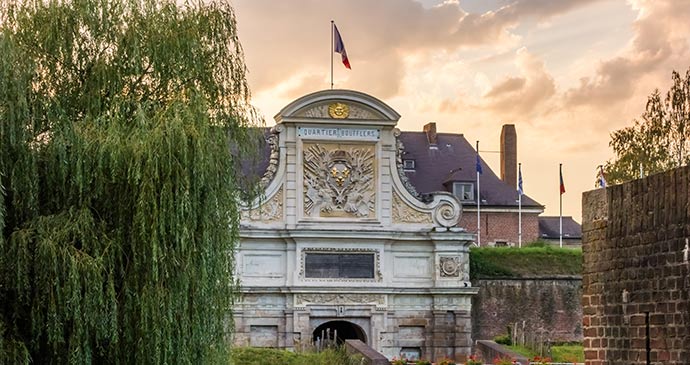 © Ralf Siemieniec, Shutterstock
© Ralf Siemieniec, Shutterstock
Citadelle
A town in its own right, France’s Queen of Citadels was the greatest fortress of the reign of Louis XIV. When the Sun King commissioned the great military architect Sébastien Le Prestre de Vauban to protect his kingdom with a ring of 100 fortified towns, this imposing and impenetrable, pentagonal, starshaped Citadelle was hailed as the masterpiece of the world’s finest military engineer. Built by 400 men in just three years using 16 million newly baked bricks, the garrison opened in 1670 as home to 1,200 soldiers. Three hundred years on, it remains the nucleus of the modern army with 1,000 French soldiers and foreign legionnaires stationed here.
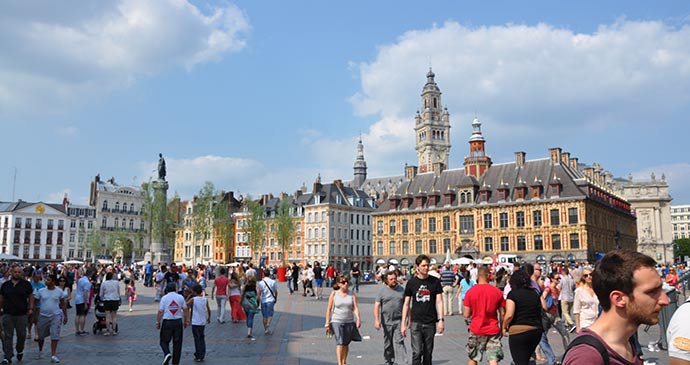 © Nord Tourism
© Nord Tourism
Grand’ Place
Named after Lille’s most famous son, but known to everyone simply as the Grand’ Place, the main square is the very heartbeat of the city. Almost pedestrianised, although a serpentine trail of traffic slithers slowly and safely along two sides, this is a veritable forum where shoppers break their day, friends plot an evening and revellers celebrate the night.
The essential rendezvous is the central fountain around the column of the Déesse, the goddess and symbol of the spirit of the city. The statue commemorates the bravery of the townsfolk, withstanding the siege of Lille by 35,000 Austrian soldiers in 1792. The original idea, mooted the day after the victory, was to build a monument by melting down all royal statues (the Revolution was at its height and Marie Antoinette had not yet been executed). Enthusiasm waned, but eventually the Déesse was cast by Théophile Bra, with the intention of placing her atop his Arc de Triomphe in Paris. That plan too was abandoned, and the goddess returned to Lille, standing for three years in place Rihour before moving to Charles Benvignat’s column on Grand’ Place in 1845.
Her crown represents Lille’s ramparts, her right hand ever ready to fire another cannon, her left pointing to a plaque inscribed with the brave words of Mayor André’s rebuttal of Austria’s demands. Tongues soon began to wag, since from upper windows locals noted the goddess’s uncanny resemblance to Mme Bigodanel, the 54-year-old wife of the then mayor. It seems her fuller figure had not gone unnoticed by the artist.
Under her watchful gaze, students hold their protest rallies, bands play on Gay Pride Weekend and the city’s tame giants parade during the Fêtes de Lille. Grand’ Place has a habit of dressing for every occasion: most famously as a Christmas grotto in December and January when, surrounded by Cinderella candelabra, a huge Ferris wheel swings sensation seekers into the skies to take in the panorama of gables and belfries from a swaying cradle high above the cobblestones. The wheel turns from mid-morning until well past midnight. Sometimes the cobbles are covered with plants, lawns and box hedges as the city gardeners decide to transform the square into a park. Perhaps the whole area will become a farmyard, with rows of market-garden cabbages in front of the theatre, and a herd of cows grazing contentedly outside McDonald’s. On one memorable visit, thousands of screaming fans turned out for a free pop concert on a sultry summer’s night, and obliging students on rooftops sprayed the crowd from mineral water bottles.
Le TriPostal
The enduring legacy of Lille2004 was the renaissance of a tired postal sorting office at the side of the Gare Lille Flandres. The harsh state-owned railway and postal service architecture lent anonymity to the site that allowed it to be reinvented with each phase of the festival. Attracting around a quarter of a million visitors in its first season, the potential of this industrial warehousestyle shell with its mail cages and three 2,000m2 galleries was irresistible.
Martine Aubry, charismatic mayor and all-round superwoman, wrested Le TriPostal from its landlords to allow it to remain open for five more years. It is still going strong more than a decade since. Shows in its first year included futuristic robots, Buckingham Palace reinvented as a council estate, and a sensual tickling machine. Since then it has highlighted gems from private collections, even a Saatchi retrospective. A key venue (and box office) for Lille3000 festivals, it also hosts special events during non-festival months and years, and is often a venue for clubbing and social events.
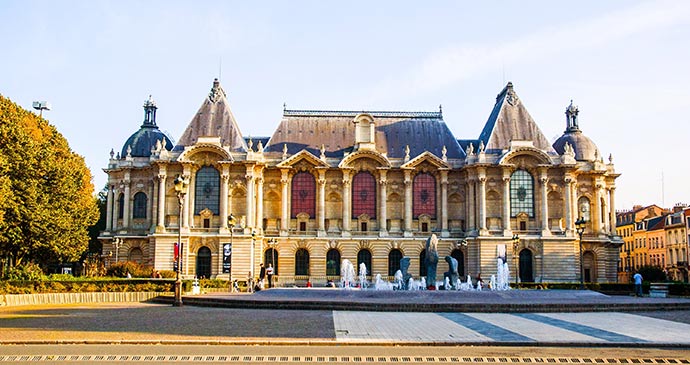 © Meiqianbao, Shutterstock
© Meiqianbao, Shutterstock
Palais des Beaux-Arts
For years, in a modest office tucked away behind the magnificent splendour of the museum, the original curator (now retired) Arnaud Brejon de Lavergnée pondered over the Palais des Beaux-Arts’s many treasures. France’s second museum after the Louvre has Goyas and Rubens, Picassos, Lautrecs and Monets, but the greatest treasure of them all was Arnaud Brejon de Lavergnée himself, self-effacing overlord of the museum’s reinvention. The passions of this modest and unassuming art lover are as much a part of this fabulous palace as the rich red walls, the floppy chairs, and the catalogue of some of the world’s greatest artworks.
During the renovations, Monsieur Brejon de Lavergnée could be seen at the station platform, clutching bubble-wrapped masterpieces to his chest as he personally escorted the Palais’s jewels to be restored at the National Gallery in London. Until the day in 1997 that President Chirac inaugurated the new museum, every picture, every frame and every detail came under his exacting scrutiny. Monsieur Brejon has since handed over the reins to Alain Tapié, who in turn passed on the responsibility to current curator Bruno Girveau, but he long continued leading privileged visitors around the museum. On the eve of a legendary Rubens exhibition, I left my allotted tour group to tag along behind the master as Monsieur Brejon laid bare the genius of the artist to a privileged party including Prince Jean of France aka Duke of Orleans, banker, philosopher, MBA, erstwhile footballer and current Dauphin and pretender to the throne.
The breathtaking art collection was brought to Lille on the orders of Napoleon, who stripped the walls of palaces and private galleries throughout his European empire, from Italy to the Low Countries. The plan paid off: what had been a pleasure for the cultured few is now a cherished symbol of civic pride, and was the triumph that awoke the world to the news that Lille had achieved greatness.
Today’s visitors take one of the twin grand staircases adorned with leaded windows heralding the arts et métiers of Lille to the first floor, where room after room offers French, Flemish and European masterpieces from the 17th to the 19th centuries. Highlights include Rubens’s Descente de la Croix, an entire room devoted to Jordaens, and a succession of highceilinged galleries housing the works of Van Dyck, Corot and Delacroix with Watteau, père et fils, the collection’s first curators. Best of all is the celebrated pair of Goyas, Les Jeunes and Les Vieilles, the former a timeless portrayal of a teenage crush, as relevant to the SMS texting generation as to its own time, and the latter a cruelly satirical dissection of old age: crones at one with their malevolence. With so many riches, it is easy to overlook the corridor devoted to the Impressionists. Make time for Monet, Van Gogh, Renoir and Sisley, not to mention Lautrec and Rodin’s Burghers of Calais.
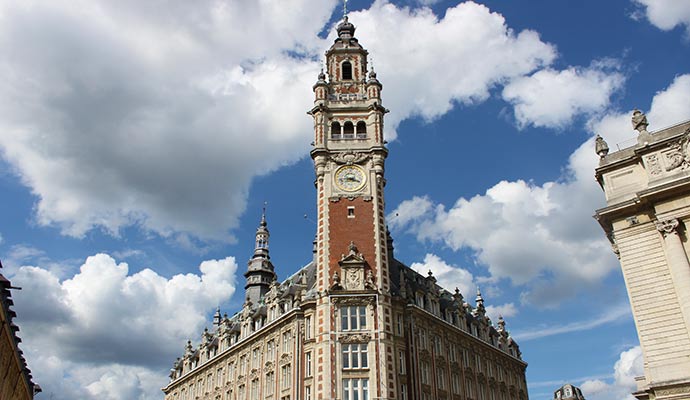 Cordonnier’s Chambre de Commerce building © Anna Moores
Cordonnier’s Chambre de Commerce building © Anna Moores
Place du Théâtre
Only pedestrianised as part of the city’s millennium renovations, this is the junction of Lille ancient and modern. Spot the iron arm hanging above the junction of rue de la Bourse and rue de la Grande Chaussée pointing visitors to Vieux Lille. The two most striking buildings on the square are surprisingly new, dating from the 20th century: the Neoclassical opera house, with its monumental sculptures of Apollo and the Muses, and the splendid 76m neo-Flemish belfry of the imposing Chambre de Commerce et d’Industrie – both built by Louis Cordonnier.
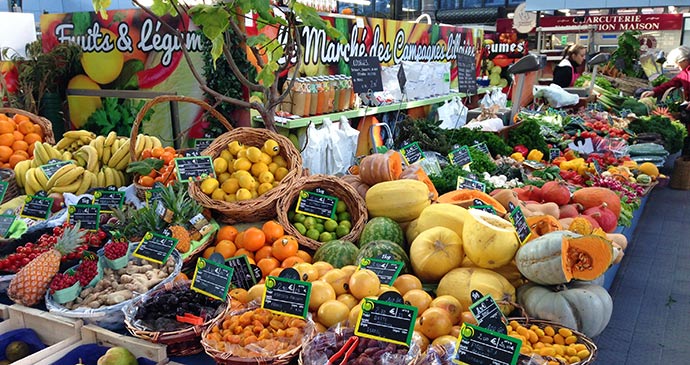
Wazemmes market
Emerge from Gambetta métro station and prepare for all your senses to be ravaged. Surrender to the pulse of the city and simply follow the crowds past puppies and chickens, rabbits and budgerigars. Around the church of St Pierre and St Paul swims the tide of humanity, past antiques, bric-a-brac and junk, past piles of clothing.
Into the place de la Nouvelle Aventure the adventure continues, past mounds of gloriously plump fresh chicory, rose-red radishes and tear-blushed artichokes from the market gardens of Artois and Flanders, past puppets and playthings, smart coats and swimwear; shop doorways flung open on a Sunday; past promises of ‘Special prices just for you Monsieur, Madame, only today from my cousin in Africa’.
Into the red-brick market hall itself: past fresh North Sea fish on the slab and crates of seafood; past cheeses from the region and beyond; past exotic sausages and pristine plucked poultry. Through the hall to the flower market: past carnations and lilies; past spring blooms or Christmas wreaths.
From café doorways hear the sound of the accordion playing. An old man on a bicycle offers bunches of herbs from his panniers to passers-by and a younger biker steps off his Harley to try on a new leather jacket for €70. Backs are slapped, hands are shaken, noses are tapped and deals are struck.
As the church bells toll for mass, traders’ cries mingle with the sound of a barrel organ. At the back of a lorry blocking the rue des Sarrazins, gleaming saucepans are offered at never-to-be repeated prices, and in the midst of the whirlpool of the market square a salesman demonstrates his miracle wonder-broom or incredible, magical vegetable-slicing machine.
All in all, Wazemmes on a Sunday morning is an unforgettable experience for bargain hunters and browsers alike.
Related books
For more information, see our guide to Lille:
Related articles
Laurence Phillips bids farewell to two Lillois dining institutions.
